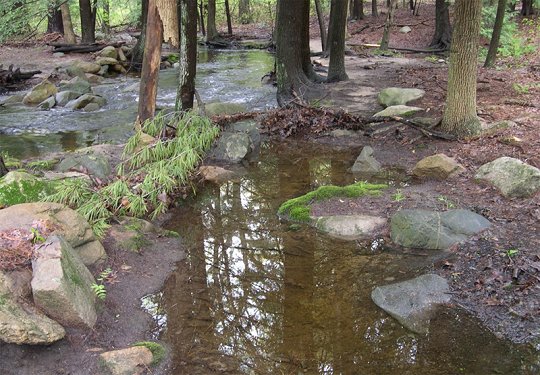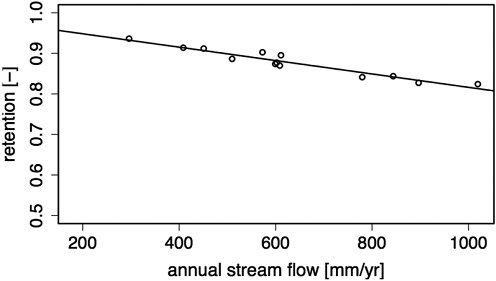By conducting large scale, long-term studies of entire river-estuary networks, PIE scientists revealed ways that human activities and natural processes interact to control the flow of water and nutrients from the land to the ocean. This science helps to guide the reduction of harmful nitrogen pollution in coastal waters.
 A myriad of human activities alter the hydrology and biogeochemistry of water running off urban and suburban lands. PIE researchers have documented many of these effects, including an intensified storm response, greater annual runoff, increased nutrient loading, and reduced capacity for nutrient retention. These changes are most evident at the scale of small headwater streams. PIE researchers have also identified that while the effects of some of these changes are felt far downstream and into the estuary, natural processes can provide important services that lessen the negative effect. For example, during summers, nitrogen inputs are greatly elevated in small headwater streams that drain suburban areas. But as water flows downstream, microbes living in the water, stream bottom,and wetlands permanently remove much ofhis nitrogen as part of the natural process of
denitrification. This greatly reduces the
A myriad of human activities alter the hydrology and biogeochemistry of water running off urban and suburban lands. PIE researchers have documented many of these effects, including an intensified storm response, greater annual runoff, increased nutrient loading, and reduced capacity for nutrient retention. These changes are most evident at the scale of small headwater streams. PIE researchers have also identified that while the effects of some of these changes are felt far downstream and into the estuary, natural processes can provide important services that lessen the negative effect. For example, during summers, nitrogen inputs are greatly elevated in small headwater streams that drain suburban areas. But as water flows downstream, microbes living in the water, stream bottom,and wetlands permanently remove much ofhis nitrogen as part of the natural process of
denitrification. This greatly reduces the
| Example of storm event flood in a suburban headwater stream (Burlington MA), showing how storm flood waters go over bankfull, deposit sand, and scour the riparian zone clear of leaf litter. Peak storm flow had occurred prior to this picture being taken (Wollheim photo). |
Humans themselves have also in
 tentionally and unintentionally offset some of the extra nitrogen that they bring into the watershed via polluted air, fertilizers, and food (which potentially enters the system through human waste). First, much nitrogen is diverted before it ever gets to streams and rivers due to sewer system construction and treatment often distant from where it is produced, alleviating the need for local natural nitrogen removal. Second, humans inadvertently divert some nitrogen when they withdraw drinking water from larger rivers. Human engineered water transport often crosses basin boundaries,
tentionally and unintentionally offset some of the extra nitrogen that they bring into the watershed via polluted air, fertilizers, and food (which potentially enters the system through human waste). First, much nitrogen is diverted before it ever gets to streams and rivers due to sewer system construction and treatment often distant from where it is produced, alleviating the need for local natural nitrogen removal. Second, humans inadvertently divert some nitrogen when they withdraw drinking water from larger rivers. Human engineered water transport often crosses basin boundaries,
| Long term data set of nitrogen exports from the watershed (1994-2009) compared to budget estimates of net inputs to the watershed indicate that more than 80% of estimated inputs are removed by watershed processes, but that this effectiveness declined in wetter years. (Wollheim et al. In Review; PIE-LTER database.) |
For further reading:
Claessens, L., C. Hopkinson, E. Rastetter, and J. Vallino. 2006. Effect of historical changes in land use and climate on the water budget of an urbanizing watershed. Water Resources Research 42:W03426.
Williams, M., C. H. Hopkinson, E. B. Rastetter, and J. Vallino. 2004. N budgets and aquatic uptake in the Ipswich R. basin, northeastern Massachusetts. Water Resource Research 40:W11201.
Wollheim, W. M., B. J. Peterson, C. J. Vorosmarty, C. Hopkinson, and S. A. Thomas. 2008. Dynamics of N removal over annual time scales in a suburban river network. Journal of Geophysical Research - Biogeosciences G03038, doi:10.1029/2007JG000660.
For further information:
Wilfred Wollheim (wil.wollheim@unh.edu)
